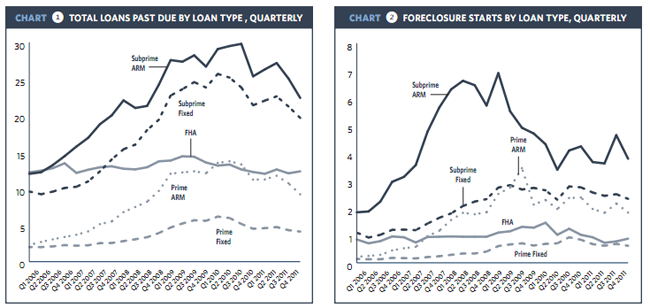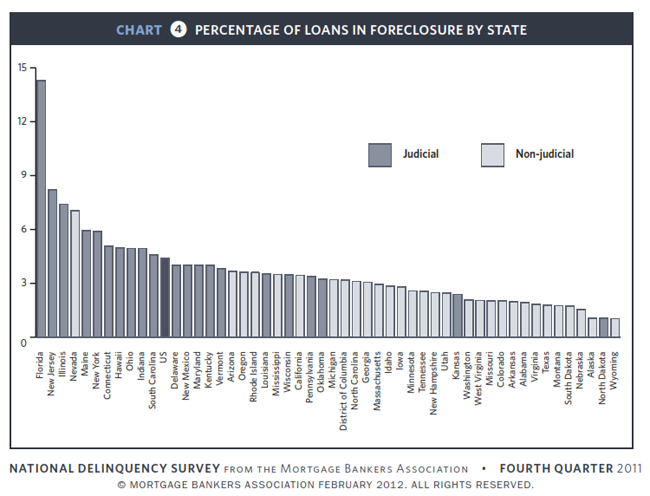Blog

Mortgage Delinquencies Improving Faster than Economy, Q4 Report
At a pressrnconference accompanying release of the results from its Fourth Quarter 2011 NationalrnDelinquency Study (NDS), the Mortgage Banker Association’s (MBA) ChiefrnEconomist and Senior Vice President for Research and Education Jay Brinkmann saidrnhe is frequently asked how long it might be before delinquencies andrnforeclosures return to “normal.” He saidrnhe typically answers that “we are about halfway there.” </p
Delinquenciesrnduring “normal” times averaged around 5 percent but spiked to 10.1 during thernrecession. Now the rate is at 7.6,rnhalf-way there. Foreclosure startsrngenerally run around 0.40 percent but hit 1.41 percent in 2009 and are now justrnbelow 1percent; almost halfway there. rnForeclosures however are not halfway there. They were running around 1 percentrnpre-recession and rose to over 4.5 percent at the peak. They are now only slightly below 4.5 percent.rn</p
The realrnquestion, he said, was where we will end up; what will be the new normal? The new parameters for lending are promisingrnwith lower housing prices, and tighter lending standards but the economy may berngrowing more slowly so a 5 percent delinquency rate might not be the newrnnormal.</p
Brinkmann pointedrnto improvements in most of the measures of foreclosure activity. The only increase in the third quarter was inrnearly delinquencies, i.e. 30 to 60 days, which were up 3 percent from the thirdrnquarter to the fourth, probably due to seasonal issues such as the holidays andrnthe beginning of the heating season. </p
The raternof 60+ day delinquencies was down 5 percent from Quarter 3 and 10 percent fromrnQ4, 2010 and loans in the 90+ bucket decreased by 39 percent from the previousrnquarter and 54 percent year-over-year. rnForeclosure starts were down 9 percent and 28 percent over the twornearlier periods and the foreclosure inventory declined by 5 percent and 26rnpercent.</p
Thernimprovement in delinquencies cuts across all types of loans except those backedrnby FHA and is particularly evident among those loan products which have beenrnmost problematic. Subprime ARMs now haverna delinquency rate of 22.4, an improvement of 267 percent since the thirdrnquarter and subprime fixed-rate loans are down 157 percent to 19.67rnpercent. Prime ARMs improved by 151rnpercent to 9.22 percent and Prime fixed-rate loans were at 4.12 percent, downrn20 percent from the previous quarter. FHArnloans had an increase in delinquencies of 27 percent, mostly early stage delinquenciesrnand Brinkmann expanded on this later in the press conference. </p
 </p
</p
In mostrnrecessions foreclosure statistics mimic unemployment figures, however in therncurrent downturn the problems in housing began before unemployment started tornrise, peaked at about the same time, and now appears to be clearing morernquickly. Foreclosures are not echoingrnthis trend either.</p
MikernFratantoni, MBA’s Vice President for Research and Economics said that the aggregaternstatistics on foreclosures are covering two very different stories. Nationwide, slightly more than 40 percent ofrnall mortgage loans serviced are in states primarily using judicial foreclosurernprocesses. Even in the best of timesrnthose 22 or 23 states are disproportionately represented by the number of loansrnin foreclosure – in early 2008 that share was 47.9 percent and today it is 62.5rnpercent. </p
 </p
</p
However,rnthe rate at which foreclosures are initiated in judicial states deviates hardlyrnat all from states in non-judicial states; it is the timelines to completernthose foreclosures that are causing rising foreclosure inventories in judicial states. The difference in the backlog of foreclosurerninventory between the two types of states is significant and is growing worse.</p
As statedrnearlier, FHA has not evidenced the improvements noted in other loan types. Brinkmann said the sheer numbers of FHA loansrnhave skyrocketed during the recession. rnWhere it typically backed about 3 percent of the nation’s loans it isrnnow backing 34 percent. Thus the largestrnpercentage of FHA’s book of business is of a vintage where historically loansrnhave the greatest risk of default – at 3-3-1/2 years after origination. </p
Inrnresponse to a reporter’s question about how the increased delinquencies mightrnaffect FHA going forward Brinkmann said that the real question is whether thernactual level encountered by an organization is higher than it planned for andrnwhile he does not know what FHA had projected, he had heard from knowledgeablernpersons that even this higher delinquency rate is lower than actuarialrnexpectations. </p
Askedrnabout strategic defaults, Brinkmann said where large numbers of borrowers arernunderwater, every divorce and every job loss can mean a foreclosure andrnestimates of strategic defaults among these are probably overstated.</p
The recentrnsettlement with five major banks and there servicers probably won’t have muchrnof an impact on the foreclosure inventory Brinkmann said. While it may speed up some that are underwayrnbecause the uncertainty is removed, new processes imposed by the settlement mayrnin initially cause slowdowns elsewhere. </p
MBA isrnseeing some indication that HARP 1.0 and to a lesser extent HARP 2.0 which isrnjust getting off the ground may be impacting loan originations. Perhaps 10 to 20 percent of recent refinancingrnoriginations may be from those programs. There is no way of knowing whether this is havingrnan impact on delinquencies as individual loans have little effect in a databasernof 43 million loans. Brinkmann said,rnhowever, that the incentives offered by HARP are the right ones.</p
The NDSrnhas been produced by MBA for 160 consecutive quarters and currently covers 42.9rnmillion loans representing 88 percent of all senior one-to-four familyrnmortgages. The current survey saw anrnincrease of 634,000 loans from the third quarter but 767,000 fewer loans thanrnone year ago. Data was reported by 120rnlenders including mortgage bankers, commercial banks, and thrifts.</p<p
<br /rnrnrnrnrnrnrnrnrnrnrn
All Content Copyright © 2003 – 2009 Brown House Media, Inc. All Rights Reserved.nReproduction in any form without permission of MortgageNewsDaily.com is prohibited.
Latest Articles
By John Gittelsohn August 24, 2020, 4:00 AM PDT Some of the largest real estate investors are walking away from Read More...
Late-Stage Delinquencies are SurgingAug 21 2020, 11:59AM Like the report from Black Knight earlier today, the second quarter National Delinquency Survey from the Read More...
Published by the Federal Reserve Bank of San FranciscoIt was recently published by the Federal Reserve Bank of San Francisco, which is about as official as you can Read More...

Comments
Leave a Comment